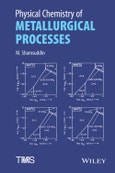Each chapter is illustrated with appropriate examples of applications of the technique in extraction of some common, reactive, rare or refractory metal together with worked out problems explaining the principle of the operation.
Table of Contents
Preface xi
Foreword xvii
List of Symbols xix
1 Introduction 1
1.1 Thermodynamic Quantities and their Interrelationships 5
1.1.1 General Thermodynamics 5
1.1.2 Solution Thermodynamics 15
Further Reading 37
2 Roasting of Sulfide Minerals 39
2.1 Methods of Roasting 40
2.2 Objectives 41
2.3 Chemistry of Roasting 42
2.4 Thermodynamics of Roasting 43
2.5 Kinetics of Roasting 47
2.6 Predominance Area Diagrams as a Useful Guide in Feed Preparation 51
2.7 Problems 53
References 68
3 Sulfide Smelting 71
3.1 Matte Smelting of Chalcopyrite 72
3.1.1 Flash Smelting 74
3.1.2 Submerged Tuyere Smelting 76
3.1.3 Matte Converting 76
3.1.4 Ausmelt/Isasmelt: Top Submerged Lancing (TSL) Technology 80
3.2 Matte Smelting of Galena 83
3.3 Matte Smelting of Nickel Sulfide 85
3.3.1 Theory of Direct Conversion of Molten Nickel Sulfide into Nickel 87
3.4 Continuous Converting 89
3.4.1 Noranda Continuous Converting Process 90
3.4.2 Outokumpu Flash Converting Process 90
3.4.3 Mitsubishi Continuous Converting Process 91
3.5 Direct Metal Extraction from Concentrates 92
3.5.1 Outokumpu Flash Smelting Process 93
3.5.2 Mitsubishi Process 94
3.6 Problems 96
References 100
4 Metallurgical Slag 103
4.1 Structure of Oxides 103
4.1.1 Role of Ion Dimension 104
4.1.2 Metal Oxygen Bonds 106
4.2 Structure of Slag 108
4.3 Properties of Slag 110
4.3.1 Basicity of Slag 110
4.3.2 Oxidizing Power of Slag 112
4.3.3 Sulfide Capacity of Slag 112
4.3.4 Electrical and Thermal Conductivity 113
4.3.5 Viscosity 113
4.3.6 Surface Tension 117
4.3.7 Diffusivity 117
4.4 Constitution of Metallurgical Slag 118
4.4.1 State of Oxidation of Slag 120
4.5 Slag Theories 125
4.5.1 Ionic Theories 126
4.5.2 Molecular Theory 130
4.6 Problems 131
References 143
5 Reduction of Oxides and Reduction Smelting 145
5.1 Reduction Methods 146
5.2 Thermodynamics of Reduction of Oxides 147
5.2.1 Metallothermic Reduction 148
5.2.2 Thermal Decomposition 154
5.2.3 Reduction with Carbon Monoxide 155
5.2.4 Reduction with Hydrogen 159
5.3 Kinetics of Reduction of Oxides 161
5.3.1 Chemical Reaction with Porous and Nonporous Product Film 162
5.4 Commercial Processes 170
5.4.1 Production of Iron 170
5.4.2 Production of Zinc 174
5.4.3 Production of Tungsten and Molybdenum 177
5.5 Problems 179
References 196
6 Interfacial Phenomena 199
6.1 Precipitation 201
6.2 Nucleation of Gas Bubbles in a Liquid Metal 205
6.2.1 Role of Interfaces in Slag Metal Reactions 208
6.3 Emulsion and Foam 209
6.4 Froth Flotation 211
6.5 Other Applications 213
6.6 Problems 214
References 230
7 Steelmaking 233
7.1 Steelmaking Processes 234
7.1.1 Bessemer Process 234
7.1.2 Open Hearth Process 235
7.1.3 Electric Arc Furnace (EAF) Process 236
7.1.4 Top–Blown Basic Oxygen Converter Process 236
7.1.5 Rotating Oxygen–Blown Converter Process 238
7.1.6 Bottom–Blown Oxygen Converter Process 239
7.1.7 Hybrid/Bath Agitated/Combined–Blown Process 240
7.2 Physicochemical Principles 242
7.2.1 Sulfur Reactions 242
7.2.2 Phosphorus Reactions 246
7.2.3 Silicon Reactions 250
7.2.4 Manganese Reactions 251
7.2.5 Carbon Reactions 253
7.2.6 Kinetics of Slag Metal Reactions 256
7.3 Pre–treatment of Hot Metal 261
7.3.1 External Desiliconization 262
7.3.2 External Desulfurization 262
7.3.3 External Dephosphorization 262
7.3.4 Simultaneous Removal of Sulfur and Phosphorus 263
7.4 Chemistry of Refining 264
7.4.1 Bessemer Process 264
7.4.2 Open Hearth Process 266
7.4.3 Electric Arc Furnace (EAF) Process 266
7.4.4 Top–Blown Basic Oxygen Converter Process 267
7.4.5 Rotating Oxygen–Blown Converter Process 272
7.4.6 Bottom–Blown Oxygen Converter Process 274
7.4.7 Hybrid/Bath Agitated/Combined–Blown Process 276
7.5 Problems 279
References 286
8 Secondary Steelmaking 289
8.1 Inert Gas Purging (IGP) 290
8.2 Ladle Furnace (LF) 291
8.3 Deoxidation 291
8.3.1 Choice of Deoxidizers 293
8.3.2 Complex Deoxidizers 294
8.3.3 Vacuum Deoxidation 299
8.3.4 Deoxidation Practice 299
8.3.5 Removal of Deoxidation Products 300
8.4 Stainless Steelmaking 301
8.4.1 Physicochemical Principles 302
8.4.2 Stainless Steelmaking Processes 305
8.5 Injection Metallurgy (IM) 307
8.6 Refining with Synthetic Slag 309
8.7 Vacuum Degassing 311
8.7.1 Nitrogen in Iron and Steel 312
8.7.2 Hydrogen in Iron and Steel 315
8.7.3 Vacuum Treatment of Steel 319
8.8 Problems 325
References 348
9 Role of Halides in Extraction of Metals 351
9.1 Preparation of Halides 354
9.1.1 Complex Fluoride Processes 354
9.1.2 Halogenation of Oxides 355
9.1.3 Halogenation of Ferro–Alloys 359
9.1.4 Crystallization from Aqueous Solution 360
9.2 Purification of Chlorides 362
9.2.1 Purification of Titanium Tetrachloride 363
9.2.2 Purification of Columbium Pentachloride 363
9.2.3 Purification of Vanadium Tetrachloride 363
9.3 Metal Production 364
9.3.1 Metallothermic Reduction 365
9.3.2 Fused Salt Electrolytic Process 369
9.4 Purification 369
9.4.1 Disproportionate Process 369
9.4.2 Iodide Process 370
9.5 Problems 370
References 380
10 Refining 383
10.1 Principle 384
10.2 Methods of Refining 384
10.2.1 Fire Refining 385
10.2.2 Metal Metal Refining 391
10.2.3 Metal Gas Refining 394
10.2.4 Miscellaneous Group 400
10.3 Ultra–purification 400
10.3.1 Zone Refining 400
10.3.2 Electro–transport 403
10.3.3 Iodide Decomposition 404
10.4 Refining along with Melting and Consolidation 409
10.5 Problems 410
References 420
11 Hydrometallurgy 423
11.1 Leaching 425
11.1.1 Leaching Methods 427
11.2 Breakdown of Refractory Minerals 431
11.2.1 Concentrated Sulfuric Acid Breakdown 432
11.2.2 Concentrated Alkali Breakdown 432
11.3 Physicochemical Aspects of Leaching 433
11.3.1 Thermodynamics of Aqueous Solutions 433
11.3.2 Stability Limit of Water 435
11.3.3 Potential–pH Diagrams 437
11.3.4 Electrochemical Phenomenon in Leaching 444
11.3.5 Kinetics of Leaching 448
11.4 Treatment of Leach Liquor 465
11.4.1 Chemical Precipitation 466
11.4.2 Fractional Crystallization 467
11.4.3 Ion Exchange 468
11.4.4 Solvent Extraction 476
11.5 Recovery of Metals from Leach Liquor 492
11.5.1 Precipitation of Metal Sulfides 492
11.5.2 Cementation 495
11.5.3 Gaseous Reduction 502
11.6 Problems 507
References 519
12 Electrometallurgy 523
12.1 Principle 525
12.1.1 Cell Potential 527
12.1.2 Discharge Potential 530
12.1.3 Current and Energy Efficiency 532
12.2 Applications 534
12.2.1 Electrowinning 534
12.2.2 Electrorefining 545
12.3 Problems 549
References 556
Appendixes 559
Index 585








